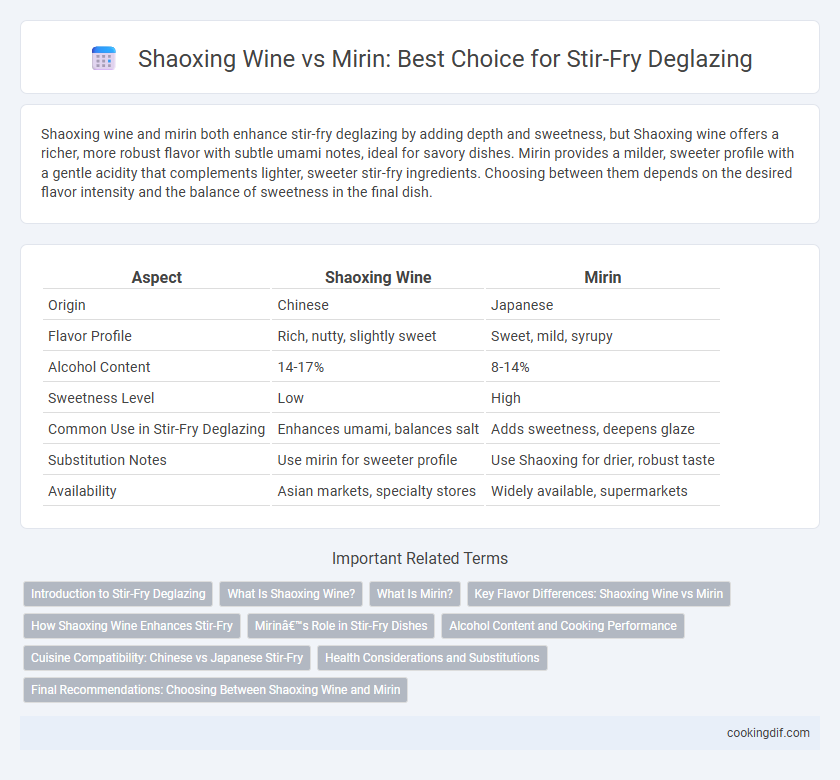Shaoxing wine and mirin both enhance stir-fry deglazing by adding depth and sweetness, but Shaoxing wine offers a richer, more robust flavor with subtle umami notes, ideal for savory dishes. Mirin provides a milder, sweeter profile with a gentle acidity that complements lighter, sweeter stir-fry ingredients. Choosing between them depends on the desired flavor intensity and the balance of sweetness in the final dish.
Table of Comparison
| Aspect | Shaoxing Wine | Mirin |
|---|---|---|
| Origin | Chinese | Japanese |
| Flavor Profile | Rich, nutty, slightly sweet | Sweet, mild, syrupy |
| Alcohol Content | 14-17% | 8-14% |
| Sweetness Level | Low | High |
| Common Use in Stir-Fry Deglazing | Enhances umami, balances salt | Adds sweetness, deepens glaze |
| Substitution Notes | Use mirin for sweeter profile | Use Shaoxing for drier, robust taste |
| Availability | Asian markets, specialty stores | Widely available, supermarkets |
Introduction to Stir-Fry Deglazing
Shaoxing wine, a traditional Chinese cooking wine, imparts a rich, savory depth ideal for authentic stir-fry deglazing, while mirin, a sweet Japanese rice wine, adds subtle sweetness and acidity. Using Shaoxing wine enhances the umami flavors by dissolving browned bits on the pan, creating a complex sauce base. Mirin's lower alcohol content and sugary profile make it suitable for balancing spicy or salty stir-fry dishes with gentle deglazing effects.
What Is Shaoxing Wine?
Shaoxing wine, a traditional Chinese rice wine brewed in Shaoxing, Zhejiang province, is prized for its rich, nutty flavor that enhances the depth of stir-fry dishes. Its robust aroma and slightly sweet, umami profile make it ideal for deglazing pans, effectively lifting browned bits and infusing sauces with complex savory notes. Unlike mirin, which is a Japanese sweet rice wine with higher sugar content, Shaoxing wine imparts a balanced acidity and subtle earthiness essential for authentic Chinese stir-fry flavors.
What Is Mirin?
Mirin is a Japanese sweet rice wine with a lower alcohol content and higher sugar level compared to Shaoxing wine, making it ideal for adding a subtle sweetness and glossy finish to stir-fry dishes. It enhances umami flavors while balancing savory and salty elements without overpowering the dish. Mirin's delicate profile distinguishes it from the more robust, dry, and slightly bitter taste of Shaoxing wine commonly used in Chinese cuisine.
Key Flavor Differences: Shaoxing Wine vs Mirin
Shaoxing wine imparts a rich, nutty, and slightly savory depth with earthy undertones, enhancing umami in stir-fry sauces, while mirin offers a sweet, mild flavor with subtle acidity that balances salty and spicy elements. Shaoxing's robust aroma and dry finish contrast with mirin's syrupy texture and gentle sweetness, making each suitable for different flavor profiles in Asian cuisine. Using Shaoxing wine creates a more complex, bold taste, whereas mirin provides a lighter, sweeter glaze during deglazing.
How Shaoxing Wine Enhances Stir-Fry
Shaoxing wine enhances stir-fry by adding a rich, nutty aroma and deep umami flavor that balances savory and sweet elements, unlike mirin, which is sweeter and less complex. Its moderate acidity helps deglaze the pan effectively, lifting caramelized bits for a more flavorful sauce. Incorporating Shaoxing wine elevates traditional Chinese stir-fries, providing authenticity and depth not matched by the milder, fruitier profile of mirin.
Mirin’s Role in Stir-Fry Dishes
Mirin enhances stir-fry dishes by adding a balanced sweetness and subtle umami, which helps to deglaze the pan and create a rich sauce that complements the ingredients. Its lower alcohol content and mild flavor profile make it ideal for quickly lifting browned bits without overpowering delicate vegetables or proteins. Using mirin in stir-fry deglazing intensifies the depth of flavor while maintaining the dish's overall harmony and texture.
Alcohol Content and Cooking Performance
Shaoxing wine contains approximately 14-17% alcohol, which provides a robust flavor and higher evaporation rate, enhancing stir-fry deglazing by deeply caramelizing and balancing savory elements. Mirin, with a lower alcohol content around 8-14% and higher sugar levels, imparts a sweeter profile and glossiness but less intensity in caramelization during cooking. The higher alcohol concentration in Shaoxing wine ensures more effective deglazing and flavor extraction in high-heat stir-fry compared to the milder, sweeter finish from mirin.
Cuisine Compatibility: Chinese vs Japanese Stir-Fry
Shaoxing wine, a traditional Chinese rice wine, offers a robust, slightly nutty flavor that enhances the savory depth of Chinese stir-fry dishes, complementing ingredients like ginger, garlic, and soy sauce. Mirin, a sweet Japanese rice wine with a mild umami profile, balances the flavors in Japanese stir-fry by adding subtle sweetness and gloss without overpowering delicate proteins like fish or tofu. Choosing Shaoxing wine or mirin for deglazing depends on the cuisine's authenticity and flavor profile, as Shaoxing integrates seamlessly into Chinese stir-fry sauces while mirin suits the lighter, sweeter notes of Japanese stir-fry.
Health Considerations and Substitutions
Shaoxing wine, a traditional Chinese cooking wine, contains a higher alcohol content and fewer sugars compared to mirin, making it a lower-calorie option for stir-fry deglazing. Mirin, a Japanese sweet rice wine, has added sugars that may affect blood sugar levels, posing concerns for individuals with diabetes or those monitoring sugar intake. For health-conscious substitutions, dry sherry or a splash of rice vinegar mixed with a bit of sugar can mimic Shaoxing wine's flavor while reducing alcohol content and sweetness in stir-fry recipes.
Final Recommendations: Choosing Between Shaoxing Wine and Mirin
Shaoxing wine offers a robust, slightly nutty flavor that enhances savory stir-fry dishes with authentic Chinese depth, while mirin provides a sweeter, milder profile ideal for Japanese-inspired recipes requiring subtle sweetness. When deglazing, Shaoxing wine's higher acidity and complex aroma help lift browned bits efficiently, intensifying umami, whereas mirin's sugar content caramelizes gently, adding a glossy finish. Select Shaoxing wine for bold, savory stir-fries and mirin for delicate, sweet-tangy finishes to best complement your dish's flavor profile.
Shaoxing wine vs mirin for stir-fry deglazing Infographic

 cookingdif.com
cookingdif.com